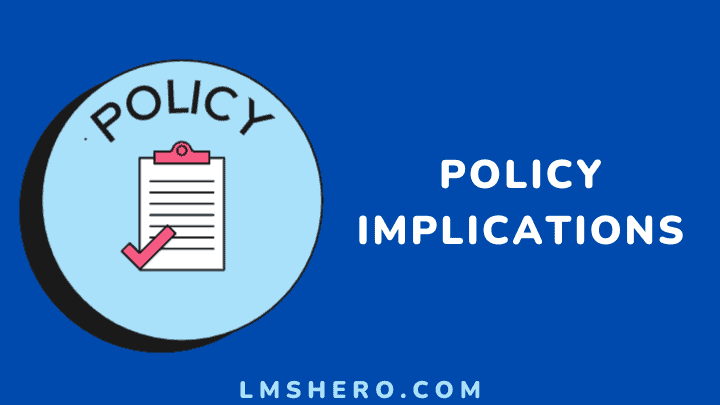Policy implications involve the process of determining the likely effects of proposed policies. It can be used to identify potential problems and opportunities that may result from adopting or implementing a policy.
Policy implications have wide-ranging consequences for society and individuals, so a thorough understanding of their meaning is important.
One of the key benefits of policy implication is that it allows us to explore different scenarios and understand how different choices might affect outcomes.
Policy implications can also help improve decision-making accuracy and priority by informing users about the consequences of different options.
This article provides an overview of the concept, focusing on its various applications and implementation strategies.
Understanding policy implications
The consequences of policy action are referred to as policy implications. Because these two terms are frequently used interchangeably, it is crucial to know the distinction between them.
Positive or negative policy implications do not imply that all policies will result in good or poor outcomes. For example, implementing a policy that offers free medical services to anyone who requests them will help alleviate poverty in your nation and enhance access to healthcare.
However, if this strategy has no other advantages besides lowering poverty and expanding access to healthcare, it would probably also have unfavorable effects (e.g., increased resource demand).
In its most basic and understandable form, the policy implication is defined as the impact of a specific policy on stakeholders. The term “policy implication” refers to the implications that policy declarations make.
This is critical when the policy’s wording is interpreted in specific contexts, such as a court of law. One should figure out what they are trying to accomplish before simply following what is written in a contract or legislation.
Furthermore, a person can only effectively use words in a court of law if you understand what they mean.
Some practical application of policy implications

1. Impact of policy implications on technology
Technology and the law have an exciting relationship. When new technologies are introduced to the public, they are often faced with questions about their legality and potential consequences.
Policy implication on technology is a way to control technology’s impact on our society. Net neutrality is one of the most significant policies currently affecting technology.
Net neutrality requires internet providers to give everyone equal access to everything without favoring some content over others.
Therefore, your internet provider cannot charge you more for using services like Netflix, Hulu, or Facebook than they would charge you for using Google.
2. Impact of policy implications on the economy and society
The economic implications of proposed policy changes are difficult to predict, but they would likely result in significant economic and societal disruptions.
If the government decides to make substantial changes to its budget, it could trigger a recession.
Alternatively, if the government chooses to maintain its current spending levels, it could lead to higher taxes, reducing investment and sparking a recession.
In either case, the effects on the economy and society would be far-reaching. Additionally, companies must be able to adapt quickly to these changes to remain competitive.
3. Impact of policy implications on the environment
Policy implications are a part of the long-term planning process. The report contains data on national parks, climate change, water resources, endangered species, and more.
Its main objective is to evaluate how best to mitigate or avoid the environmental effects of a proposed policy. If no mitigating action can be identified, there is potential for adverse environmental impacts.
Policy implications on the environment can take many forms including:
- Environmental impact assessment (EIA) – A formal process that evaluates the effect of the proposed development on the environment.
- Mitigation measures – Any measures are undertaken to reduce or prevent any adverse effects on the environment that would otherwise have occurred with no mitigation measures being taken; and
- Mitigation strategy – This is a plan for implementing mitigation measures to reduce or avoid any adverse environmental impacts.
Despite several policy implications, the impact of government policies on the environment is often exaggerated or not fully understood. Hence, policymakers must consider all the relevant factors when making environmental decisions.
4. Impact of policy implications on education
The impact of policy implications on education is described as the direct influence of policy decisions on the functioning of the educational system.
The direct influence of policy decisions on education can be measured by examining the changes in enrollment and achievement levels in schools or other institutions caused by changing policies.
The indirect influence of policy implications on education refers to the changes in educational outcomes that occur when specific policies affect other policies or conditions that affect educational outcomes (e.g., funding, teacher quality).
Whichever way, the impact of policy implications on education is significant. It can impact how a curriculum is taught, how students are taught, and how they are evaluated. The changes in policies will have an impact on teachers, parents, and students.
Modeling in policy implications
A model is a set of assumptions about the world and its behavior. Modeling in policy implications is using simulation or mathematical models to explore how different policies might change real-world outcomes.
It tries to simulate how real-world events occur so that policymakers can test out different scenarios to see what would happen if they made certain changes.
The results are then used to inform decisions about the future. A simple example is a model of unemployment in which people have varying skills, which affect their productivity and wages.
Policy implications and implementations
It is critical to remember that implementing these policies must come first before discussing the policy implications. Policy changes and their consequences follow policy implementation.
Implementing policies is a critical step in the process, so passing policies does not guarantee the desired results. The desired outcomes of a policy can only be achieved by following the implementation process.
The implementation of policies involves all levels of government, the commercial sector, civil society organizations, and others. However, challenges persist because the situational context and implementing agents’ beliefs and priorities differ across policy areas and systems.
As a result, there are no “one-size-fits-all” solutions. It is important to recognize that implementation research is diverse, and thus stakeholders should not look for a single common theory.
Instead, depending on the policy area and context, developing partial theories that mix and match the most convincing elements of different theories should suffice.
FAQs
How do you write implications and recommendations?
A good way to write implications and recommendations would be to summarize the study’s findings, discuss the implications, and then outline specific recommendations.
How do you identify implications?
To identify the policy implications, it is important to know what the issue is and who it impacts.
Who is responsible for implementing a policy?
An organization responsible for implementing a policy is responsible for its implementation. The most important thing is ensuring that all stakeholders know the new policy and their responsibilities.
Final thoughts
Before understanding policy, one must understand the context in which policies are used. Any business, organization, or individual must respond to circumstances or strategies to achieve goals that are important to them.
Otherwise, the goals may be unattainable, or scaling up to those goals may be difficult. Policies must be understood within the context of a company or other entity.
It is critical to understand that policies serve as rules, regulations, and guidelines to help a company achieve its goals. Organizations create policies to achieve their goals and objectives.
Policies should be implemented within the framework of organizational culture, values, and norms to ensure their success in achieving corporate goals.
As a result, any organization or individual who wishes to implement policies effectively must understand them thoroughly.
You can also read more on incentive management as a strategy for businesses to have fun and stay focused.
Thanks for reading.






